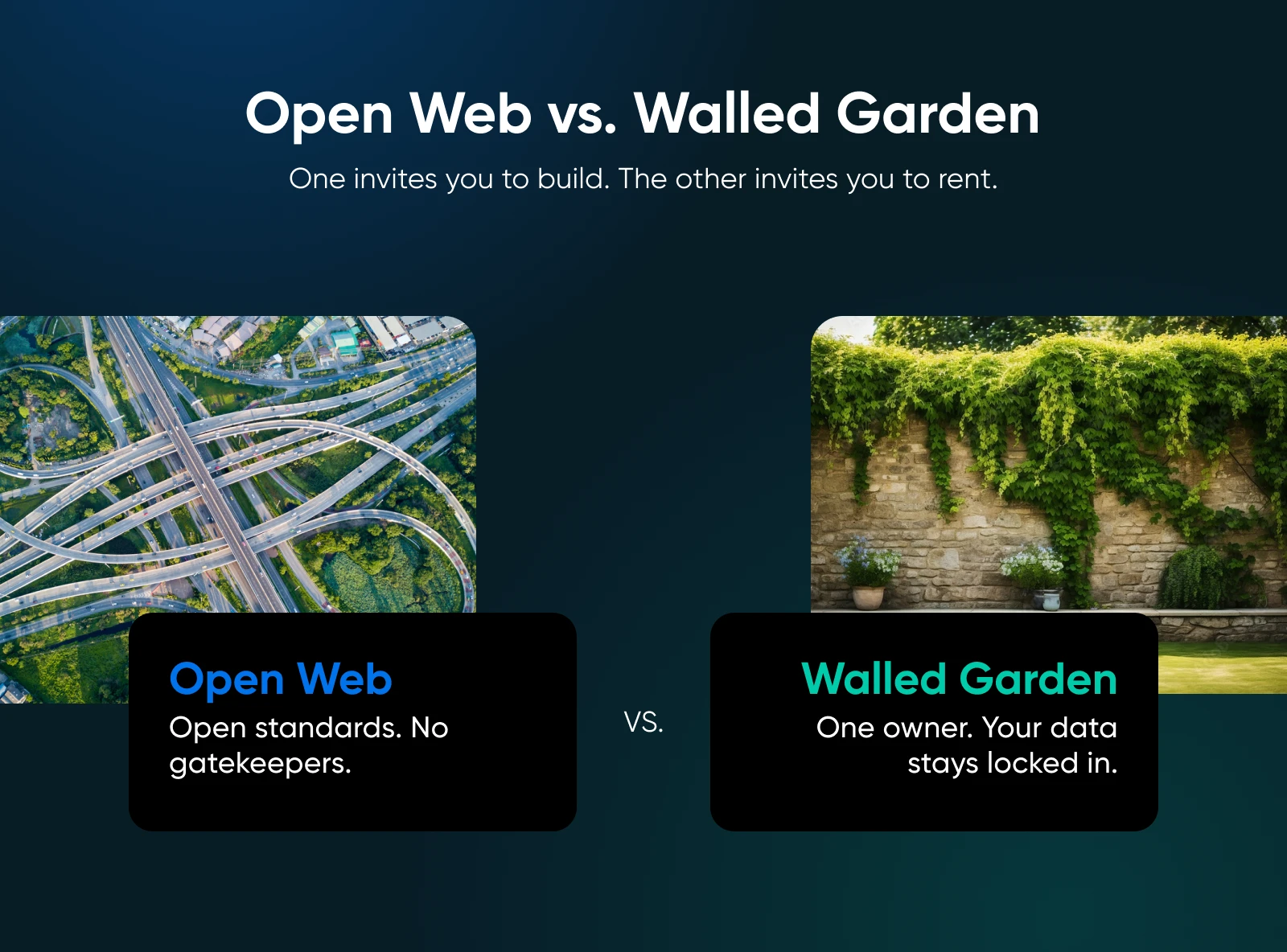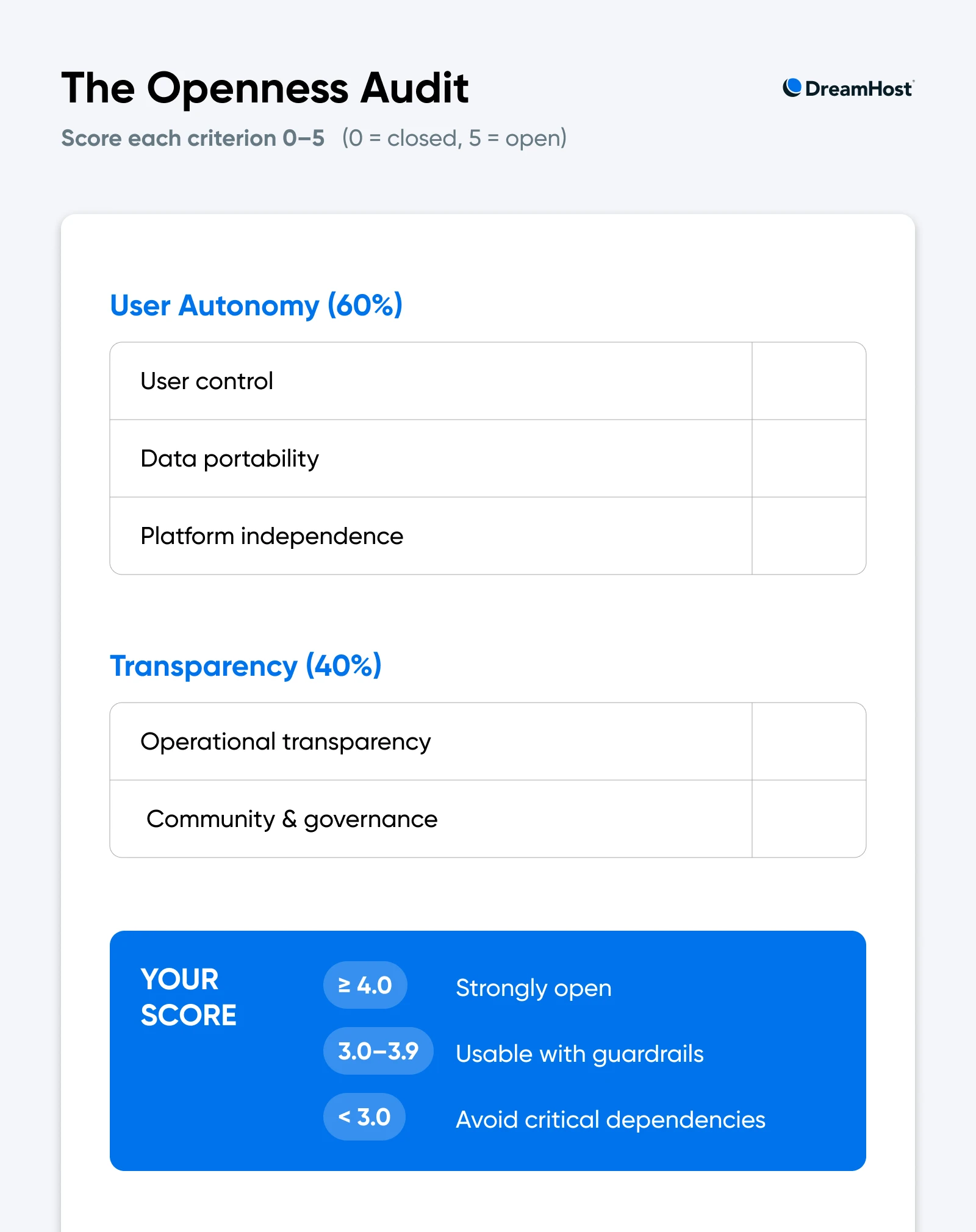What Is the Open Web? Open Web ←→ Walled Garden

TL;DR: The Open Web is the part of the internet built on open standards that let you build, move, and integrate without a single vendor’s permission; walled gardens trade that freedom for convenience and control.
Treat openness as a spectrum: Your stack can be more or less open at each layer, and those choices compound. Use the Openness Audit to score vendors across two dimensions:
Bottom line: Choose tools that make leaving possible so staying is always your choice.
A few months back, headlines swirled about Perplexity, an AI company saying, essentially, “What if we just… bought Chrome?” Was it a stunt? Maybe.
But it was also a reminder that whoever controls the gateway — the browser, the app store, the feed —controls what you see, how you build, and how easily you can leave.
That’s the Open Web conversation in a nutshell.
When we say “Open Web,” we mean the part of the internet built on open standards and interoperable protocols: stuff anyone can implement and no single company can revoke. You can build on it, move across it, and connect to it without asking for permission.
A “walled garden,” on the other hand, is a closed ecosystem where a single vendor sets the rules, limits movement, and holds your data behind a velvet rope. Sometimes that rope looks like great UX. But it’s still a rope.

If you’re a designer or developer juggling client sites, you already feel the stakes. A platform changes its pricing or rate limits, and suddenly you’re spending a weekend rebuilding flows you shipped last year. And your client doesn’t blame the platform; they blame you.
This isn’t just a moral philosophy; it’s the difference between owning your stack and renting it month to month.
At DreamHost, we’ve staked our business on the mundane-but-important idea that you should be able to move freely on the web, because that’s what real ownership means. We advocate for open-source tools and data portability not because it’s trendy, but because it’s how you protect your time, your customers, and your margins.
That’s what we’re exploring in this article, and it all comes down to the real meaning of the Open Web.
What Is the Open Web?
The Open Web is all the parts of the internet built on open standards and standardized protocols (think HTML, CSS, HTTP, DNS), developed in transparent, multi-stakeholder processes —and usable without any one company’s permission. In practice, that looks like tools you can self-host or move between providers, data you can export in common formats, and integrations that don’t require a back-channel deal.
A walled garden is the opposite: a closed ecosystem where one vendor sets the rules, limits movement, and mediates access, often via proprietary formats, opaque policies, and gatekept distribution (app stores, feeds, marketplaces). The UX can be great, but the trade-off is platform dependence.
Why the Open Web Matters To Small Businesses
If you run a small business, “open vs. closed” isn’t a philosophy debate; it’s how many late nights you’ll spend fixing things you didn’t break. The Open Web gives you room to move. You can switch tools, keep your data, and adapt without rebuilding the whole kitchen every time a vendor changes the menu.
Here are some of the Open Web’s benefits for small businesses:
- You stay in control when platforms change the rules: Prices go up, APIs rate-limit, features disappear. If your site and data are portable, you move on your terms, with no emergency rebuilds and no apologizing to customers for problems you couldn’t predict.
- Migrations become projects, not crises: When your content lives in common formats (think JSON/CSV/WXR) and your tools offer documented read/write APIs, a big move is just a checklist, not a fire drill.
- You can mix the best tools for the job: Open protocols make it easy to pair the CMS you love with a storefront, CRM, or analytics tool that actually fits. You don’t wait for a vendor to greenlight an integration — you connect it and go.
- Compliance is simpler when your data can move: New privacy rules or client requests? Export, transform, delete, without asking a platform for special access.
- You can say “yes” more often: New channel, new campaign, or a better plugin? With an open foundation, you add pieces without ripping up the floorboards.
👉Here’s the bottom line: The Open Web doesn’t make work vanish, but it does make it predictable. Your customers won’t see every decision you made under the hood, but they’ll feel the difference between “we planned for this” and “we’re stuck.”

The Open Web Is a Spectrum (Not a Binary)
Every tool you use sits somewhere between “wide-open and portable” and “tightly controlled and sticky.” Your choices across that spectrum compound: own your domain and DNS, choose a portable CMS, keep data in open formats, and prefer tools with write-enabled APIs.
Suddenly, you can reconfigure your stack without starting over.
But go the other way with proprietary formats, closed integrations, and black-box pricing, and routine changes turn into rebuilds.
Here’s what to keep in mind:
- Openness varies by layer: You might run a very open site (for example, using a self-hosted CMS) while depending on a less-open email or analytics vendor. That’s normal. The goal is to keep the foundation open so swaps above it don’t hurt.
- Openness changes over time: Vendors get acquired, terms evolve, APIs tighten. Revisit where each tool sits on the spectrum at renewal. Moving a little bit closer to open is a win.
The point isn’t purity. It’s control. When your foundation lives on the more open side, you decide when to move and what to keep.
The Openness Audit: Evaluate Your Stack Through an “Open” Lens
Give every major tool in your stack a quick, evidence-based check before you buy (or renew).
This audit looks at two dimensions across five criteria to tell you how much control you retain and how many surprises to expect.
Dimension 1: User Autonomy
Dimension 2: Transparency
How To Score Your Tools and Platforms
- User autonomy = 60% (because the power to act matters slightly more than the power to see)
- Transparency = 40%
- Average the three Autonomy scores and multiply by 0.6
- Average the two Transparency scores and multiply by 0.4
- Add them for a 0–5 composite
- ≥ 4.0: Strongly open and predictable
- 3.0–3.9: Usable with guardrails. Document exports and set a review date
- < 3.0: Treat as a short-term or channel play and avoid critical dependencies
See It In Practice: Layer By Layer Examples
- User control: 5
- Data portability: 5
- Platform independence: 5
- Operational transparency: 3-4 (depends on host)
- Community and governance: 4-5
- Total score: 4.4-4.8
- Assessment: Safe as a core layer, with predictable updates and migrations
- User control: 3
- Data portability: 4
- Platform independence: 3-4 (depending on platform; you can switch, but deliverability setup matters)
- Operational transparency: 4
- Community and governance: 2-3
- Total score: 3.2-3.6
- Assessment: Usable with guardrails. Keep all exports up-to-date and DNS ready to swap
- User control: 1-2
- Data portability: 2
- Platform independence: 1
- Operational transparency: 2
- Community and governance: 1-2
- Total score: 1.4-1.8
- Assessment: Use only for reach, never for infrastructure

Apply This Audit to Your Current Stack
Your goal isn’t to flip your entire tech stack at once, but to move everything closer to open each renewal cycle. Follow this checklist to audit all your tools and platforms and prepare to move to more portable foundations.
1. Domain and DNS
- Do now: Confirm you control the registrar login and DNS. Export your zone file.
- Quick win: Move DNS to a provider that supports zone exports, DNSSEC, and programmatic updates.
- For the future: Keep a copy of the zone file in version control.
2. Hosting and Backups
- Do now: Confirm that you can generate full site/database backups on demand and schedule daily backups.
- Quick win: Store off-site copies (object storage) and document the restore steps.
- For the future: Run a quarterly test restore to a staging environment.
3. CMS
- Do now: Verify content/media exports and imports (e.g., WXR for WordPress) and list all plugins with versions.
- Quick win: Replace any plugin that locks data in proprietary tables without export tools.
- For the future: Keep a minimal plugin set and pin versions and changelogs.
4. E-commerce and Payments
- Do now: Identify where product, order, and customer data live. Document bulk export formats and write-enabled APIs.
- Quick win: Sync customer/order data to a separate database or data warehouse in open formats.
- For the future: Abstract your payment gateway behind your own code, so swapping processors isn’t a rebuild.
5. CRM and Email
- Do now: Confirm contact list export/import, suppression lists, and event/engagement exports.
- Quick win: Mirror subscriber data to a neutral store you control.
- For the future: Use your domain for sending with proper DNS (SPF/DKIM/DMARC) so switching ESPs won’t nuke deliverability.
6. Analytics and Ads
- Do now: Check data ownership and export cadence.
- Quick win: Add a lightweight, self-hostable analytics option alongside ad-network pixels to keep first-party insight if a platform changes access.
- For the future: Maintain a server-side event pipeline you control.
7. Media and Assets
- Do now: Keep originals in open formats (SVG/PNG/JPEG/WEBP, WAV/FLAC, MP4), with folder structure and metadata.
- Quick win: Use a storage bucket with lifecycle rules and object versioning.
- For the future: Don’t rely on a vendor’s in-app media library as your only source of truth.

Frequently Asked Questions About the Open Web
Is the Open Web always “better” for users?
Not always for day-one convenience, but usually for long-term control. If you pick speed now, make an exit plan and build in regular exports.
Is data portability enough by itself?
No. You also need interoperability (write-enabled APIs) and transparency (clear pricing/policies) so you can act before surprises hit.
How often should I re-run the audit?
At renewal, after major feature/policy changes, or annually — whichever comes first.
What’s a good target score?
Aim for ≥ 4.0 on foundational layers (domain/DNS, hosting, CMS), because that’s where openness saves real time: migration in hours instead of days, routine upgrades without vendor delays, and fewer rebuilds. For edge tools, 3.0-3.9 is workable with guardrails as long as you keep exports current and block critical dependencies. Anything that scores lower than 3.0 should be a short-term tool.
What if a critical tool scores low, but we can’t replace it yet?
Isolate it behind your code, mirror its data to an open store, and schedule a time-boxed proof-of-migration so you’re not starting from zero later.
The Open Web isn’t a club you join; it’s a set of habits you practice. Gateways will continue to concentrate power — browsers, feeds, app stores — and vendors will continue to change prices, policies, and APIs. You can’t control that. You can control how entangled you are when it happens.
Treat openness as a spectrum. Keep the foundation portable (domain, DNS, hosting, CMS), prefer tools that export cleanly and write via APIs, and rehearse a small piece of your exit plan before you need it.
Use the audit to score what you have now, then nudge one step more open at each renewal. That’s how you turn philosophy into a runway.
In the end, “open” isn’t about being purist. It’s about being ready. The teams that can move, do. The ones that can’t, wait.
Your advantage is simple: choose tools that make leaving possible, so staying is always your choice.



